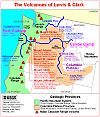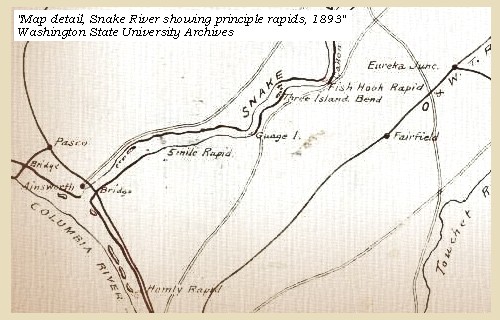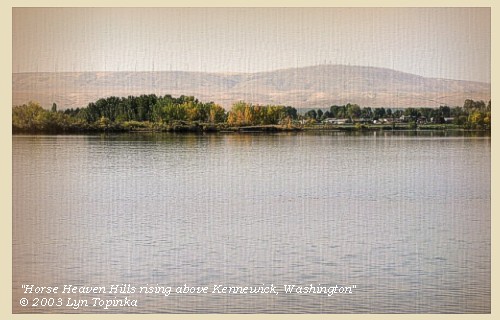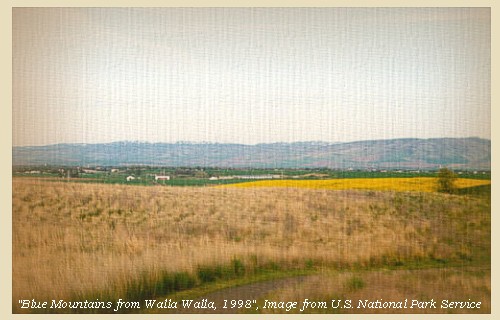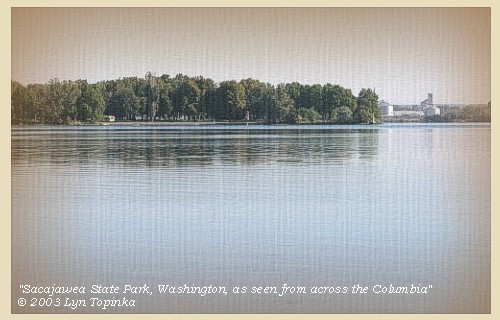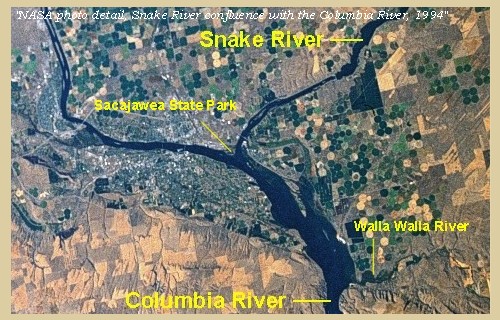
Junction of the Snake River with the Columbia River:
The Snake River joins the Columbia River at River Mile 325, near Pasco, Washington. Lewis and Clark spent two nights camped at the junction, a spot known today as Sacajawea State Park.











- Map, Junction Snake River with the Columbia River (#9), October 16, 1805
- 1814 Map, Lewis and Clark (section of original). (Click to enlarge.)
Shows the junction of the Snake River ("Lewis's River", just visible on the right) with the Columbia River (running through the middle of the map).
From the "Nicholas Biddle/Paul Allen" 1814 publication.
Original Map: "A Map of Lewis and Clark's Track, Across the Western Portion of North America, From the Mississippi to the Pacific Ocean".
From: History of the expedition under the command of Captains Lewis and Clark : to the sources of the Missouri, thence across the Rocky Mountains and down the river Columbia to the Pacific Ocean : performed during the years 1804-5-6 : by order of the government of the United States / prepared for the press by Paul Allen. Philadelphia : Bradford and Insskeep, 1814.
Harold B. Lee Library, Brigham Young University #upbover maps37.
-- Brigham Young University, Harold B. Lee Library Website, 2004.
- 1853 Map, Washington and Oregon and the Columbia River,
from the Clearwater River to the Snake River and down the Columbia River to the Pacific Ocean (section of original). (Click to enlarge).
Includes: Clearwater River (Kooskooski), Lapwai Creek (Lapwai R.), Snake River (Saptin or Lewis R.), Columbia River (Columbia R.), Yakima River (Yakima R.), Walla Walla River (Wallawalla R.), Umatilla River (Umatilla R.), Willow Creek (Quesnells R.), John Day River (John day's R.), Deschutes River (Fall R.), Willamette River (Willammette R.), and Cowlitz River (Cowlitz R.).
Original Map: "Map of California, Oregon, Washington, Utah, and New Mexico (1853)",
by Thomas Cowperthwait & Co.
Washington State University Archives #WSU22.
-- Washington State University Library Collections Website, 2003
- 1853-54 Map, Columbia River, including the Horse Heaven Hills area (section of original). (Click to enlarge).
Includes Horse Heaven Hills ("lands destitute of timber"), Willow Creek, Umatilla River, Walla Walla River, Touchet River,
Twin Sisters ("Chimney Rock"), Yakima River, and the junction of the Snake River (only the "S" shows) with the Columbia.
Original Map: "Rocky Mountains to Puget Sound : from explorations and surveys / made under the direction of the Hon. Jefferson Davis, Secretary of War by Isaac I. Stevens Governor of Washington Territory, 1853-4."
Inset: (Supplementary sketch) Reconnaissance of the railroad route from Wallawalla to Seattle via Yak-e-mah River & Snoqualmie Pass. By A. W. Tinkham in January 1854. Drawn by J. R. P. Mechlin. 20 x 28 cm.
Topographer, John Lambert, Published in Washington D.C., 1859, 1:1,200,000, Notes: From the U.S. War Department, Explorations and Surveys for a Railroad Route from the Mississippi River to the Pacific Ocean, Topographical Maps, to Illustrate the Various Reports, U.S. Library of Congress American Memories Reference "LC Railroad Maps #156".
-- U.S. Library of Congress, American Memories Website, 2004
- 1855 Map, Clearwater and Snake Rivers,
including the Confluence of the Snake River (Lewis Fork) and
Columbia River (not named) (section of original). (Click to enlarge).
Original Map: "Map of Oregon and Washington Territories: showing the proposed Northern Railroad route to the Pacific Ocean,
by John Disturnell, 1855.
University of Washington Archives #UW155.
-- University of Washington Library Collections Website, 2002
- 1858 Military Recon Map (section of original),
Snake River entering the Columbia River. (Click to enlarge).
Map of military reconnaissance from Fort Dalles,
Oregon, via Fort Wallah-Wallah, to Fort Taylor, Washington Territory,
1858. Shows approximate location of military road
constructed 1859 to 1862. From the report and maps of
Captain John Mullan, United States Army, G.P.O., 1863.
University of Washington Archives #UW85.
-- University of Washington Library Archives Website, 2002
- 1882 Map, Snake River Confluence with the Columbia River (section of original). (Click to enlarge).
Original Map: "Map of the Upper Columbia River from the international boundary line to Snake River, on a scale of one inch to two miles,
1882, Sheet 25."
U. S. Army Corps of Engineers, 1882.
Washington State University Historical Maps Collection #WSU505.
-- Washington State University Library Archives Website, 2002
- 1893 Map, part of the Snake River
showing location of principal rapids (section of original).
Includes Fish Hook Rapids.
(Click to enlarge). Original Map: "Part of the Snake River from its mouth
to the Grande Ronde, showing location of principal rapids".
U.S. Engineers Office, 1893.
Washington State University Historical Maps Collection #WSU586.
-- Washington State University Library Archives Website, 2002
- 1987 Map, Snake River confluence with the Columbia River (section of original). (Click to enlarge). Includes Sacajawea State Park.
Office of Coast Surveys, Historical Maps and Charts,
Columbia River, Juniper to Pasco, 1987, Chart#18542, 1:20,000.
-- NOAA Office of Coast Survey Website, 2004
- 1994, NASA Image, Columbia River from Crow Butte to the Snake River
(section of original) (Click to enlarge).
View from space - Columbia River, Snake River, Yakima River, Walla Walla River, Umatilla River,
Crow Butte and Wallula Gap,
north-looking, low-oblique photograph, September 1994.
NASA Earth from Space #STS064-112-093.
-- NASA Earth from Space Website, 2002
- 1994, NASA Image, Columbia River and the junction of the Snake River
(section of original) (Click to enlarge).
View from space - Columbia River and the Snake River,
north-looking, low-oblique photograph, September 1994.
NASA Earth from Space #STS064-112-093.
-- NASA Earth from Space Website, 2002
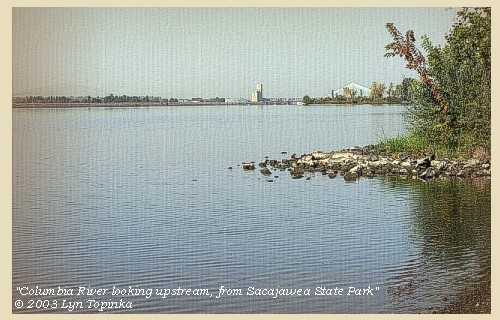
Columbia River:
The Columbia River and its tributaries form the dominant water system in the Pacific Northwest. The mainstem of the Columbia rises in Columbia Lake in British Columbia, Canada. After flowing a path for 1,270 miles, the Columbia joins the Pacific Ocean near Astoria, Oregon. The major tributaries of the Columbia are the Kootenai, Flathead/Pend Oreille/Clark's Fork, Snake, and Willamette. The largest of these tributaries, the Snake, travels 1,038 miles from its source in Yellowstone National Park in Wyoming. The Snake River enters the Columbia at Columbia River Mile 325, near Pasco, Washington.
On May 12, 1792, the American Captain Robert Gray, became the first explorer to enter the Columbia River
by crossing over the sandbar that blocked its mouth. Gray sailed about 20 miles up the estuary of the river, traded with the Indians for a few days, and then left after drawing a chart of the mouth of the river. He named the river the Columbia after his ship, and claimed it for the United States.
British Captain George Vancouver obtained a copy of Gray's chart from the Spanish governor at
Nootka Sound and sailed to the mouth of the Columbia River in October 1792.
He was unable to get his flagship Discovery over the sandbar, but Lt. William Robert
Broughton succeeded with his smaller ship, the Chatham. Broughton advanced nearly 100 miles to a site opposite present-day Portland, Oregon, which he named Point Vancouver. To the east he saw a majestic mountain peak which he named
Mount Hood.
--
U.S. Army Corps of Engineers, 2002, and
University of Virginia Library Special Collections Website, 2002






- 1798 Map, Columbia River of George Vancouver (section of original). (Click to enlarge).
Includes Columbia River, Cape Disappointment, Point Adams, Point Vancouver, and Mount St. Helens.
Original Map: George Vancouver's "A Chart Shewing Part of the
Coast of N.W. America." In A Voyage of discovery to the North Pacific ocean, and Round the World. London, 1798.
University of Virginia Special Collection "Lewis & Clark, The Maps of Exploration 1507-1814".
-- University of Virginia Library Archives Website, 2004
- 1814 Map, Lewis and Clark (section of original). (Click to enlarge.)
Shows the Columbia River from Deer Island (left) to the junction with the Snake River ("Lewis's River", right).
From the "Nicholas Biddle/Paul Allen" 1814 publication.
Original Map: "A Map of Lewis and Clark's Track, Across the Western Portion of North America, From the Mississippi to the Pacific Ocean".
From: History of the expedition under the command of Captains Lewis and Clark : to the sources of the Missouri, thence across the Rocky Mountains and down the river Columbia to the Pacific Ocean : performed during the years 1804-5-6 : by order of the government of the United States / prepared for the press by Paul Allen. Philadelphia : Bradford and Insskeep, 1814.
Harold B. Lee Library, Brigham Young University #upbover maps37.
-- Brigham Young University, Harold B. Lee Library Website, 2004.
- 1853 Map, Washington and Oregon and the Columbia River,
from the Clearwater River to the Snake River and down the Columbia River to the Pacific Ocean (section of original). (Click to enlarge).
Includes: Clearwater River (Kooskooski), Lapwai Creek (Lapwai R.), Snake River (Saptin or Lewis R.), Columbia River (Columbia R.), Yakima River (Yakima R.), Walla Walla River (Wallawalla R.), Umatilla River (Umatilla R.), Willow Creek (Quesnells R.), John Day River (John day's R.), Deschutes River (Fall R.), Willamette River (Willammette R.), and Cowlitz River (Cowlitz R.).
Original Map: "Map of California, Oregon, Washington, Utah, and New Mexico (1853)",
by Thomas Cowperthwait & Co.
Washington State University Archives #WSU22.
-- Washington State University Library Collections Website, 2003
- 1853-54 Map, Columbia River, including the Horse Heaven Hills area (section of original). (Click to enlarge).
Includes Horse Heaven Hills ("lands destitute of timber"), Willow Creek, Umatilla River, Walla Walla River, Touchet River,
Twin Sisters ("Chimney Rock"), Yakima River, and the junction of the Snake River (only the "S" shows) with the Columbia.
Original Map: "Rocky Mountains to Puget Sound : from explorations and surveys / made under the direction of the Hon. Jefferson Davis, Secretary of War by Isaac I. Stevens Governor of Washington Territory, 1853-4."
Inset: (Supplementary sketch) Reconnaissance of the railroad route from Wallawalla to Seattle via Yak-e-mah River & Snoqualmie Pass. By A. W. Tinkham in January 1854. Drawn by J. R. P. Mechlin. 20 x 28 cm.
Topographer, John Lambert, Published in Washington D.C., 1859, 1:1,200,000, Notes: From the U.S. War Department, Explorations and Surveys for a Railroad Route from the Mississippi River to the Pacific Ocean, Topographical Maps, to Illustrate the Various Reports, U.S. Library of Congress American Memories Reference "LC Railroad Maps #156".
-- U.S. Library of Congress, American Memories Website, 2004
- 2003, Looking across the Columbia River towards Horse Heaven Hills.
(Click to enlarge). Image taken from Sacajawea State Park.
Copyright © 2003 Lyn Topinka, private archives, used with permission.
- 2003, Columbia River, looking upstream from Sacajawea State Park, Washington. (Click to enlarge).
Copyright © 2003 Lyn Topinka, private archives, used with permission.
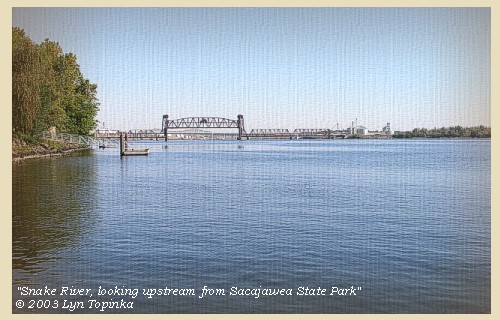
Snake River:
The Snake River originates in Yellowstone National
Park at 9,500 feet and winds through southern Idaho
before turning north to form the boundary between
Idaho and Oregon. It finally joins the Columbia River at Mile 325 near Pasco, Washington, 1,036 miles from its source. Elevation at the confluence is 340 feet.
How did it get its name? To
identify themselves, Indians living along the river in
southern Idaho used a hand sign that resembled the
movement of a snake. Although it didn't mean "Snake",
that name was given to this group of people, now known
as Shoshone. The river flowing through the Snake
Indian lands was given the tribal name.
-- U.S. National Park Service,
Wild and Scenic Rivers Website, 2002,
and
Idaho State Parks and Recreation Website,
2002






- 1814 Map, Lewis and Clark (section of original). (Click to enlarge.)
Shows the Snake River ("Lewis's River") from Canoe Camp (right) to its junction with the Columbia River (left).
From the "Nicholas Biddle/Paul Allen" 1814 publication.
Original Map: "A Map of Lewis and Clark's Track, Across the Western Portion of North America, From the Mississippi to the Pacific Ocean".
From: History of the expedition under the command of Captains Lewis and Clark : to the sources of the Missouri, thence across the Rocky Mountains and down the river Columbia to the Pacific Ocean : performed during the years 1804-5-6 : by order of the government of the United States / prepared for the press by Paul Allen. Philadelphia : Bradford and Insskeep, 1814.
Harold B. Lee Library, Brigham Young University #upbover maps37.
-- Brigham Young University, Harold B. Lee Library Website, 2004.
- 1853 Map, Washington and Oregon and the Columbia River,
from the Clearwater River to the Snake River and down the Columbia River to the Pacific Ocean (section of original). (Click to enlarge).
Includes: Clearwater River (Kooskooski), Lapwai Creek (Lapwai R.), Snake River (Saptin or Lewis R.), Columbia River (Columbia R.), Yakima River (Yakima R.), Walla Walla River (Wallawalla R.), Umatilla River (Umatilla R.), Willow Creek (Quesnells R.), John Day River (John day's R.), Deschutes River (Fall R.), Willamette River (Willammette R.), and Cowlitz River (Cowlitz R.).
Original Map: "Map of California, Oregon, Washington, Utah, and New Mexico (1853)",
by Thomas Cowperthwait & Co.
Washington State University Archives #WSU22.
-- Washington State University Library Collections Website, 2003
- 1853-54 Map, Columbia River, including the Horse Heaven Hills area (section of original). (Click to enlarge).
Includes Horse Heaven Hills ("lands destitute of timber"), Willow Creek, Umatilla River, Walla Walla River, Touchet River,
Twin Sisters ("Chimney Rock"), Yakima River, and the junction of the Snake River (only the "S" shows) with the Columbia.
Original Map: "Rocky Mountains to Puget Sound : from explorations and surveys / made under the direction of the Hon. Jefferson Davis, Secretary of War by Isaac I. Stevens Governor of Washington Territory, 1853-4."
Inset: (Supplementary sketch) Reconnaissance of the railroad route from Wallawalla to Seattle via Yak-e-mah River & Snoqualmie Pass. By A. W. Tinkham in January 1854. Drawn by J. R. P. Mechlin. 20 x 28 cm.
Topographer, John Lambert, Published in Washington D.C., 1859, 1:1,200,000, Notes: From the U.S. War Department, Explorations and Surveys for a Railroad Route from the Mississippi River to the Pacific Ocean, Topographical Maps, to Illustrate the Various Reports, U.S. Library of Congress American Memories Reference "LC Railroad Maps #156".
-- U.S. Library of Congress, American Memories Website, 2004
- An arid region along the Snake River, Washington. (Click to enlarge).
Photograph Date: between 1891 and 1936. Photographer: unknown.
American Environmental Photographs Collection #AEP-WAS141,
Department of Special Collections, University of Chicago Library.
-- U.S. Library of Congress, American Memories Website, 2002
- ca.1900, Steamer on the Snake River, near Asotin, Washington. (Click to enlarge).
Steam rises from atop the 'Lewiston' steamboat as it passes Asotin, Washington, approximately
8 miles downstream of the confluence of the Clearwater River and the Snake River.
Photographer: Wilkin Photo Service, Lewiston, Idaho. Photograph date: ca. 1900.
Washington State University Libraries Archives, #11108
-- Washington State University Library Archives Website, 2002
- 2003, Snake River, looking upstream from Sacajawea State Park, Washington. (Click to enlarge).
Copyright © 2003 Lyn Topinka, private archives, used with permission.
|

